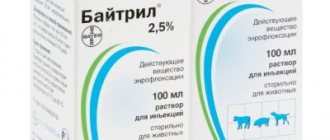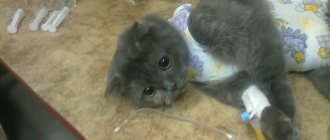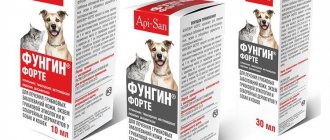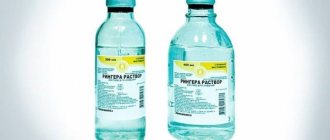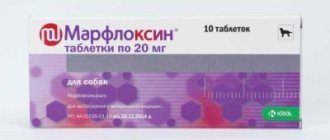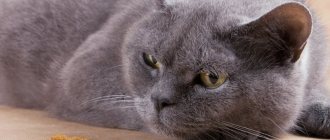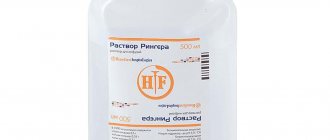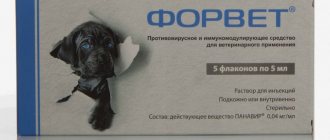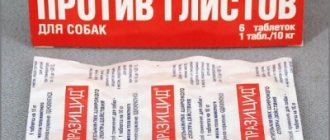Composition and release form
The main component and active ingredient of Bonharen is hyaluronic acid in the form of sodium hyaluronate. Its concentration is 10 mg per 1 ml of medicinal liquid. The composition also includes sodium chloride and purified water for injection.
Externally, the medication is a colorless transparent solution. It is intended for injection or eye drops. The sterile liquid is packaged in glass bottles, the volume of which can be 2 and 6 ml. They are closed with rubber stoppers and packaged with aluminum lids to maintain sterility. Usually there are 6 bottles in a package, but it is easy to buy the required number at the pharmacy, since they are sold individually.
Analogues and prices
The cost of 1 bottle, which contains 6 ml, is about 2600 rubles. You can buy it from distributors of veterinary drugs, at a pet store, veterinary pharmacy or animal clinic.
The following drugs have a similar therapeutic effect:
- Chionat. Belongs to the group of chondroprotectors. The active ingredient is sodium hyaluronate. The drug is injected into a vein or inside a joint (intra-articular). The duration of the therapeutic course is from 3 to 8 injections. During treatment of dogs with this medicine, no complaints of side effects were recorded. The cost of 1 bottle, the volume of which is 2 ml, is about 2500 rubles.
- X-Gia. The active substance is hydrolyzed human umbilical cord tissue. Prescribed for the treatment and prevention of diseases of the musculoskeletal system in dogs and farm animals. It can be recommended for the purpose of correcting age-related changes in joints and diseases that occur during the period of active growth and skeletal formation in puppies. Injections are made into the soft tissue in the area of the affected joint. Restrictions on use include individual intolerance to the drug. If the treatment rules were followed (dosage, duration of the therapeutic course, etc.), no side effects were recorded in animals. The average cost is 1300 rubles. per bottle of 12 ml.
In order not to cause additional harm to the dog, you should use the drug only on medical advice. You should not administer the medicine yourself if you do not have the appropriate medical skills. An incorrectly administered injection can cause the animal’s condition to worsen.
Pharmacological properties
Dogs are active animals. They spend a lot of time on the move, which affects their health as they age. Owners often encounter joint diseases in their pets. Old animals are most susceptible to them.
Over time, the production of joint fluid is disrupted, and it also loses its lubricating properties, which leads to increased friction. This is accompanied by severe pain, lameness and other unpleasant symptoms. Painkillers that are prescribed in such cases only help to temporarily eliminate the symptoms of the problem, but do not get rid of the cause.
For the effective treatment of joint diseases, Bonharen is used, which has a complex effect on the body and stops the process of destruction of cartilage tissue in animals. Hyaluronic acid is found in the body of animals and humans. It is involved in many physiological processes, and also acts as the main component of joint fluid, the deficiency of which leads to serious problems with motor function.
Bonharen has the following effects on the body:
- restores joint mobility;
- reduces pain;
- relieves inflammatory processes;
- improves the lubricating properties of joint fluid;
- triggers the regeneration of damaged cartilage tissue;
- strengthens joints and stops their destruction.
The production of joint fluid allows the animal to move without restrictions.
Advantages of the drug
Bonharen has the following advantages:
- Safety. It has no contraindications or side effects, since the main component – hyaluronic acid – is found in the body of animals.
- Fast action. In just 3-4 hours, the medicine reaches the most distant foci of inflammatory processes.
- Long lasting effect. The therapeutic effect of the injection lasts for several days.
- Rarely causes allergic reactions, because does not contain genetically modified organisms and aggressive chemicals.
- Not addictive. There is no need to constantly take the drug. For older animals, it may be necessary to repeat the course over time.
- Complex impact. It not only relieves unpleasant symptoms and alleviates the animal’s condition, but also eliminates the cause and gives a chance for a complete recovery in the initial stages of cartilage destruction.
Although the medication is safe, consult your doctor before use. Don't self-medicate!
Purpose
Diseases of the joints and tendon-ligament apparatus in domestic animals have recently become widespread. And if in people arthritis is considered a disease of the elderly, then in dogs arthritis and arthrosis are diagnosed even at a young age.
The development of arthritis can be the result of joint dysplasia, which has several degrees of severity and can cause various pathologies:
- osteochondrosis;
- dislocation of the hip joint;
- ligament rupture;
- secondary arthritis, etc.
There are no drugs that can completely stop progressive arthritis, relieve pain and restore joint mobility. Surgical operations are also ineffective if they are performed on older animals. But Bonharen is able to reduce the severity of the disease and avoid complications. It has shown to be effective in the treatment of arthritis in dogs, and clinical trials of the drug have shown that the drug is a good alternative to traditional methods of treating the disease.
The medicine contains a low molecular weight formula of hyaluronic acid, which has 100% bioavailability. Entering the joint, it stops the development of the inflammatory process, restores tissue and normalizes the synthesis of HA. The medicine can be administered subcutaneously or intramuscularly. Injections are more convenient than tablets - they act faster, and after 2-3 minutes you can feel the therapeutic effect, whereas with any tablets with a similar effect it occurs no earlier than 3-4 days.
All diseases of the locomotor system can be divided into acute and chronic. The first include wounds, various types of trauma, acute arthritis, ruptured ligaments and tendons, and sprains. Bonharen is used as part of complex therapy aimed at restoring damaged tissue.
Chronic diseases:
- bursitis;
- arthrosis;
- deforming arthritis;
- polyarthritis;
- tendonitis;
- tendovaginitis;
- dysplasia of the hip and elbow joints
Bonharen has shown its effectiveness in treating this type of disease. It is prescribed for acute and chronic arthritis and arthrosis, tendovaginitis, polyarthrosis, bursitis, non-infectious osteochondrosis in dogs.
The therapeutic effect is aimed at normalizing the process of hyaluronic acid synthesis, eliminating inflammation and restoring joint mobility. So, with bursitis, a pathology caused by inflammation of the joint capsule, which contains synovial fluid, the dog experiences increased pain, and mobility is limited in the damaged joints.
The disease can have several causes:
- consequences of injury;
- infectious diseases;
- excess weight, which increases the load on the joints;
- autoimmune diseases.
Chronic forms of the pathology sometimes require surgical intervention, but in most cases conservative treatment is prescribed, including the introduction of hyaluronic acid.
Veterinarians often prescribe Bonharen, which has many advantages over other drugs of similar action. It is safe and has no contraindications for use, since it contains only natural ingredients. The medicine is characterized by its rapid action - it only takes 3-4 hours for the active substances to reach even the most distant foci of the inflammatory process. In this case, the therapeutic effect lasts up to several days.
The drug is not addictive, does not require daily use, and extremely rarely causes negative consequences. In addition, Bonharen has a wide spectrum of action. It not only relieves the symptoms, but also eliminates the reason why the cartilage is destroyed, thereby giving the animal a good chance of recovery.
Despite the complete safety of taking Bonharen, it should not be used for self-medication. It is important to contact a veterinarian at the first signs of joint disease and undergo a full examination.
In most cases, Bonharen is prescribed for the treatment of pathologies of the musculoskeletal system:
- arthritis and arthrosis;
- osteochondrosis;
- bursitis;
- tendovaginitis and others.
However, the medicine is no less effective in the treatment of eye diseases - hyaluronic acid is used as a moisturizer:
- with conjunctivitis;
- keratitis;
- infectious eye diseases;
- corneal damage.
Indications for use
According to the instructions, Bonharen for dogs is prescribed for the treatment of the following pathologies:
- arthritis;
- arthrosis;
- osteochondrosis;
- tendinitis;
- tenosynovitis;
- non-infectious bursitis;
- other joint disorders.
The medication can be used to treat chronic, subacute and acute diseases. Can be used as an auxiliary medicine for ruptured or sprained ligaments, fractures and other injuries. Hyaluronic acid accelerates the processes of regeneration and wound healing. It is also used as eye moisturizing drops in the following cases:
- with keratitis;
- with conjunctivitis;
- with keratitoconjunctivitis;
- for ulcers and wounds of the cornea.
For eye diseases caused by infections, Bonharen is used in combination with other medications.
Important! Never use the drug to treat eye diseases without first consulting your doctor!
Instructions for use
Bonharen is easy to use. Injections are given to dogs intravenously or subcutaneously. When calculating the dose, the weight of the animal is taken into account:
- for dogs weighing up to 5 kg, 0.1 ml of medication will be required for each kilogram of weight;
- for pets weighing from 5 to 80 kg you need 0.05 ml of the drug per kilogram.
The medicine can be used for pregnant and lactating bitches, since it does not cause mutations in the fetus and does not have a negative effect on the organisms of the mother and offspring.
When performing injections, it is important to follow the rules of asepsis and simple recommendations:
- Carry out the procedure wearing sterile gloves.
- Use a new sterile syringe each time.
- Carefully draw the drug from the bottle into the syringe. It is not necessary to open it at all; you can pierce it with a needle.
- Wipe the injection site with alcohol before injecting the solution.
Depending on the stage of the disease and the condition of the animal, the course consists of 3-7 injections. Injections are given at intervals of 5-7 days.
For eye diseases
If the product is used to treat conjunctivitis and other eye diseases, 1-2 drops should be used. The procedure is repeated every 2-12 hours. The course of treatment is 5-7 days and is determined by a veterinarian.
If the medicine is used with other ophthalmic drugs, you should wait 30 minutes or more between instillations. Eye ointments are used after Bonharen.
Contipro: Bonharen forte, 1% sodium hyaluronate injection solution, 6 ml, price for 1 ampoule
Bonharen forte for the treatment of musculoskeletal and ophthalmological diseases in horses, dogs and cats
COMPOSITION AND RELEASE FORM Bonharen forte is a medicine in the form of a 10% solution for injection. 1 ml of Bonharen forte contains 10 mg sodium hyaluronate (sodium salt of hyaluronic acid) as an active ingredient, and sodium chloride and water for injection as auxiliary components. The drug is a clear, colorless and viscous solution for injection. Available packaged in glass bottles of 6 ml. The bottles are sealed with rubber stoppers, reinforced with aluminum caps, equipped with tamper evident caps and packaged in group cardboard boxes of 3 bottles.
PHARMACOLOGICAL PROPERTIES Sodium hyaluronate, which is part of Bonharen, is the sodium salt of hyaluronic acid, a linear polysaccharide consisting of alternating parts of D-glucuronic acid and N-acetyl-D-glycosamine. Sodium hyaluronate is found in the connective tissue of animals, regardless of species and has an identical chemical composition. The highest concentrations are found in synovial fluid, the vitreous body of the eye and the umbilical cord. The surfaces of articular cartilage are covered with a thin layer of protein-hyaluronic complex. Sodium hyaluronate is also found in synovial fluid and in the cartilage matrix. Sodium hyaluronate normalizes the cellular composition and viscosity of the joint fluid, improves its lubricity, activates the mobility of granulocytes and macrophages, eliminates the consequences of inflammatory processes and helps restore the physiological function of the joint. The breakdown of the amorphous layer in the joint is associated with the breakdown of fibrous tissue, which leads to the breakdown of chondrocytes and bone hyperplasia. Fragmentation of the perivascular extracellular matrix causes migration of lymphocytes, monocytes and polymorphic cells from the blood into the synovial fluid. These cells release various factors that modify hyaluronic acid, leading to changes in the rheological properties of the synovial fluid. The concentration of sodium hyaluronate increases in the tissues of the eye and tear fluid after injuries and during treatment. It protects the cornea from damage, prevents moisture loss, increases moisture retention on the surface of the cornea, increases the moisture content of the cornea due to its ability to bind water molecules, it also promotes the healing of erosions on the cornea and prevents their appearance. In addition, sodium hyaluronate is a bacteriostatic substance that reduces healing time by approximately 50%. Sodium hyaluronate is characterized by synergism with certain drugs (for example, gentamicin and tobramycin) and with fibronectin. The use of sodium hyaluronate for xerosis (xerophthalmia) of the eye slows down the rate of evaporation of water from the tear fluid, which leads to inhibition of degradation of the triocular tear film. The concentration of sodium hyaluronate in plasma is low and is about 100-300 ng/ml. In the body, sodium hyaluronate is completely and quickly metabolized. After intravenous administration, the half-life in blood plasma is from 2.5 to 4.5 minutes. The main site of metabolism is the liver, particularly the liver endothelial cells. In terms of the degree of impact on the body of warm-blooded animals, Bonharen Forte is classified as a low-hazard substance (hazard class 4 according to GOST 12.1.007-76), in recommended doses it does not have a locally irritating or sensitizing effect, and does not have cumulative properties.
INDICATIONS Bonharen is prescribed for horses, dogs and cats: diseases of the musculoskeletal system - treatment of acute and chronic arthrosis, polyarthrosis, subacute and chronic arthritis of non-infectious origin, acute and chronic tendovaginitis, tendinosis, bursitis and osteochondrosis of non-infectious etiology, joint dysfunction accompanied by lameness. ophthalmological diseases - acute and chronic keratitis, conjunctivitis and keratoconjunctivitis, xerosis (xerophthalmia), as well as ulcers and damage to the cornea.
DOSES AND METHOD OF ADMINISTRATION For diseases of the musculoskeletal system, Bonharen forte is administered to animals intravenously or subcutaneously at the rate of: horses - at a dose of 0.01 ml of the drug per 1 kg of animal body weight (0.1 mg of sodium hyaluronate), dogs weighing from 5 to 80 kg - at a dose of 0.05 ml per 1 kg of animal body weight (0.5 mg of sodium hyaluronate), for dogs and cats weighing up to 5 kg - at a dose of 0.1 ml per 1 kg of animal body weight (1 mg of sodium hyaluronate). In horses, the drug is also administered intra-articularly at a dose of 2 ml (20 mg sodium hyaluronate) per animal. The course of treatment is 3–7 injections with an interval of 5–7 days. For ophthalmological diseases, the drug is administered in the form of drops into the conjunctival sac, 1 - 2 drops per affected eye every 2 - 12 hours. The course of treatment is: from 5 to 7 days in a row - for acute inflammation; up to 60 days in a row - for chronic inflammation (until improvement or complete cure). No symptoms arising from an overdose of the drug have been identified. Bonharen forte can be used during pregnancy and lactation. Omissions should be avoided when administering the next dose of the drug, as this may lead to a decrease in effectiveness. If one dose is missed, the use of the drug is resumed as soon as possible at the same dose according to the same regimen.
SIDE EFFECTS When using the drug in accordance with the instructions, adverse reactions and complications, as a rule, are not observed. If allergic reactions occur, stop using the drug and, if necessary, carry out desensitizing therapy. In some animals, diffuse swelling may appear at the injection site, which disappears after 24 to 48 hours.
CONTRAINDICATIONS Contraindication for use is individual intolerance to the components of the drug (including a history of). Bonharen forte must not be administered through a catheter used for the administration of other medications, or mixed with any solutions. The interaction of the drug with cationic drugs based on erythromycin, amoxicillin, cefkinome causes the coagulation of sodium hyaluronate.
SPECIAL INSTRUCTIONS Animal products after using the drug can be used for food purposes without restrictions.
PERSONAL PREVENTION MEASURES When working with Bonharen forte, you should follow the general rules of personal hygiene and safety precautions provided for when working with medications. During work, it is prohibited to drink, eat, or smoke. After finishing work, wash your hands with soap. If the drug accidentally comes into contact with the skin or mucous membranes, it should be washed off with water. People with hypersensitivity to the components of the drug should avoid direct contact with Bonharen. Empty bottles of the drug must not be used for household purposes; they must be disposed of with household waste. If allergic reactions occur or if the drug accidentally enters the human body, you should immediately contact a medical facility (bring with you the instructions for use of the drug or the label).
STORAGE CONDITIONS: In a dry place, protected from light and out of reach of children and animals. Separated from food and feed at temperatures from 2 to 25 °C. Do not freeze! Shelf life: 3 years.
Contraindications and side effects
The only contraindication is individual intolerance to the components, which is quite rare. If allergic reactions occur, stop taking the drug. Usually, all unpleasant symptoms go away on their own after stopping the injections; symptomatic treatment is less often required.
Some animals experience swelling at the injection site. They do not require special treatment and disappear in a couple of days.
Bonharen should not be taken with certain types of antibiotics (erythromycin, cefkin, amoxicillin). They promote the clotting of hyaluronic acid.
Storage rules and special instructions
To ensure that the injection solution does not lose its pharmacological properties, it is necessary to ensure the correct storage conditions:
- air temperature from +5 to +25˚C;
- place inaccessible to ultraviolet radiation;
- no high humidity.
In addition, children should not have access to Bonharen. It should be located away from pet food and food. The medicine may only be stored in its original packaging. If the seal of the bottle is broken, you should not use the medicine, as well as after the expiration date.
Follow standard practices for handling veterinary drugs. Be sure to wash your hands, especially if the solution comes into contact with them. If the medicine gets on the mucous membranes, it should be washed off immediately.
Bonharen
20 hours ago, johnnik said:
When inserting into a vein, a catheter is not needed, an injection if it is done by a professional. doctor or nurse, do it directly into a vein. A catheter is placed in case of long-term injections or IVs and then for no more than 5 days. And s/c or iv does not play a role, it’s just that iv “reach” the “addressee” faster, that is, the drug is absorbed faster, that’s all.
To each his own.
We were talking about something completely different, that if you choose subcutaneous administration and into a vein, then definitely into a vein. And if there are no doctors nearby who are good at injecting with a needle, then they use a catheter. And to minimize injury to the veins, it is better to use a smaller size, for cats, and not a butterfly, because Part of the drug will remain in the butterfly, because it's thick. And to get into the vein, and not past the vein.
As for the fact that subcutaneous administration and into a vein are equivalent, one can also think in a simplified way. The less a person knows, the simpler everything looks to him. The entire competent medical and veterinary world is guided in its judgments by clinical research. Any good doctor, when receiving or discussing any information, is always focused on an authoritative source - research. Naturally, such doctors are more educated, competent, and their thinking, judgments, and approaches differ from the thinking of those who think “why, I tried it, no one seems to have died.”
The therapeutic equivalence of different forms of administration is equivalent if confirmed by high-quality studies.
By the way, an example, when a defect in injectable prednisolone arose, I received a question from one therapist asking me to look into it, and I began to delve into it. Then I went in to tell her and one doctor came up and said that “Prednisolone Nycomed Takeda is bad, because when they dilute it with saline solution in a syringe, it thickens.” I paid attention to the instructions, where there is a separate warning that this is a ready-made solution and cannot be diluted. She asked why such a bad thought came to mind. Turns out. thinks it's better this way.
I didn’t waste time on explaining, I’m not interested in people with such a superficial approach, I think it’s unacceptable for a doctor to treat medications this way. I just said that the composition of the drugs is carefully verified and then tested. If the doctor does not have data confirming the continued effectiveness and, first of all, the safety of such experiments, how can this be done.
Well, as for the discovery of America, you are averaging and simplifying everything and everyone. Well, that's your approach. But for me it’s different. And your position is close to those who think like you. For me, your approach looks wild and superficial, unacceptable, and for you I’m worrying too much. There are reasons, you know, to bother. Therefore, those who read also perceive differently, but all the years that I have been writing, I have been focusing on a certain category of people. The rest I just ignore.
Owner reviews
Olga, collie owner:
“They injected the drug for joint problems. There was a result. The dog became more active and stopped whining in pain. True, later they selected a cheaper domestic analogue, the result remained the same.”
Vita, owner of a German shepherd:
“They injected Bonharen into an old shepherd dog. I find it difficult to answer how effective the drug is, since I did not notice any visible improvements, although no progression of arthrosis was noted. If it had not been prescribed by a doctor whom I trust, I would hardly have bought it.”
Mikhail, staff owner:
“When my dog was 1.5 years old, he suffered an injury - a dislocated knee. Kron limped for a long time, and the medications used did not help or gave a temporary effect until we got an appointment with an experienced veterinarian. He prescribed a course (6 injections) of Bonharen. Now the dog is more than 3 years old and we no longer remember the lameness and pain.”
Reviews
Ekaterina, 42 years old, Tomsk
“My Amadeus began to limp, let's go to the vet. They prescribed a course of Bonharen. I was afraid to inject myself, so every week we went to the clinic, the course lasted 1.5 months. Amadeus began to run freely. The only negative is that the drug is expensive (3 thousand rubles per bottle). We needed 3 ampoules - one was enough for 2 injections.”
Vitaly, 36 years old, Ufa
“We injected Bonharen into Rottweilers at the kennel. They gave it subcutaneously at the withers, 0.5 ml per 10 kg of weight, that is, 1 ampoule was enough for 2 injections in a dog weighing 60 kg. For the course, 3 bottles were taken for each Rottweiler. The effect is noticeable immediately – it becomes easier for the animal to walk, activity returns, and appetite improves.”
